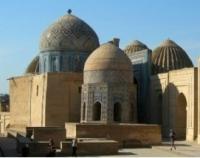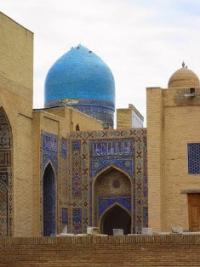You are here
The mausoleum Octahedron.


Tours to Shakhi-Zinda necropolis in Samarkand.
“People usually feel funny, smile and laugh when I tell them
about my strong belief in the very existence of prehistoric
advanced technology and great civilizations of wilier races.
I just can't wait to see their faces at time the truth is revealed”
Toba Beta.
Package tourists in Samarkand.
In the middle group, the “Fortress-free” torture mausoleum, resembling the tower mausoleums of western Iran and Azerbaijan, is being typologically built for the ensemble. The remaining part of it is represented by an octahedral pavilion without a dome with through lancet arches on the sides of the faces, in the underground part there is a crypt.
The manifestation of the architectural form “Octahedron”, which is so unusual for the ensemble of Shakhi-Zinda and in general for Samarkand, is most likely due to Azerbaijani masters, whom Timur had brought to the capital. Not far from the Shirin-bika-aka mausoleum, markedly different from other structures, there is an octahedral mausoleum of the first half of the XVth century with openings on either side.
The octahedron mausoleum, the third on the right side of the corridor, belongs to the time of Ulugbek on the facing technique. It is decorated with a mosaic of glazed bricks and was probably originally covered with a dome on a high cylindrical drum.
The octahedron mausoleum (Ist third of the XVth century) in the form of a rotunda with through arches, the third on the right side, belongs to the time of Ulugbek in terms of lining technique. It has a discreet decor: the outside is brick and Kashin mosaic, the inside on the dome is painted blue on white.
During the excavations near the Octahedron, tombstones of some non-preserved mausoleum were discovered. On the left side of the path, behind the Shadi-Mulk mausoleum, there is an almost continuous building: the excavations have uncovered the remains of ancient mausoleums, crypts, and rich majolica tombstones.
The mausoleum was restored in 1957. During the restoration of K.A. Shakhurin conducted archaeological autopsy. Several tombstones, previously dated to the XIV century, were found, for there are no historical inscriptions on the tombstones.
Archaeological autopsies revealed several tombstones; no inscriptions. Further, the mausoleums were preserved only on the western side of the corridor; between them once stood the same mausoleums, of which there were only foundations hidden under a layer of graves.
As studies have shown, several mausoleums disappeared from the ground without a trace. The time of their construction and the names of the persons buried in them are unknown.
Authority:
Alexey Arapov. Samarkand. Masterpieces of Central Asia. Tashkent, San’at. 2004
Photos
Alexander Petrov.







